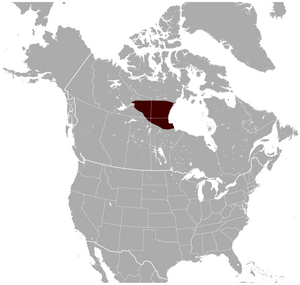Richardson's collared lemming facts for kids
Quick facts for kids Richardson's collared lemming |
|
|---|---|
| Conservation status | |
| Scientific classification | |
| Genus: |
Dicrostonyx
|
| Species: |
richardsoni
|
 |
|
| Richardson's collared lemming range | |
The Richardson's collared lemming (Dicrostonyx richardsoni) is a small North American lemming. It lives in the cold, open lands of Canada. These lemmings are sometimes thought to be a type of Arctic lemming or northern collared lemming.
Contents
What Does the Richardson's Collared Lemming Look Like?
This lemming has a short, chunky body. Its fur is usually a mix of brown and grey, sometimes reddish-brown. It has a thin dark stripe along its back. Its belly is a reddish-grey color.
It has small ears, short legs, and a very short tail. A reddish band of fur crosses its chest like a collar. In winter, its fur turns completely white. This helps it blend in with the snow. It also grows bigger claws on its front feet. These claws are great for digging in the snow and ice.
A Richardson's collared lemming is about 13 centimeters (5 inches) long. Its tail is only about 1 centimeter (less than half an inch) long. It weighs around 60 grams (about 2 ounces), which is like a small apple.
Where Do Richardson's Collared Lemmings Live?
These animals live in the tundra region of north-central Canada. This area is west of Hudson Bay. The tundra is a very cold, treeless plain.
What Do They Eat?
Richardson's collared lemmings are herbivores, meaning they eat plants.
- In summer, they munch on grasses, sedges, and other green plants.
- In winter, when fresh plants are covered by snow, they eat twigs from willow, aspen, and birch trees.
Who Are Their Predators?
Many animals hunt Richardson's collared lemmings for food. Some of their main predators include:
- Snowy owls
- Mustelids (like weasels)
- Arctic foxes
How Do They Live?
Richardson's collared lemmings are active all year round. They are busy both day and night.
- They create paths through the plants on the surface.
- They also dig burrows underground, above the frozen soil called permafrost.
- In winter, they dig tunnels under the snow. This helps them stay warm and safe from predators.
Lemming populations often go through a cycle. Their numbers grow very high for three or four years. Then, their population drops sharply. When there are too many lemmings in one area, they spread out to find new places to live.
Reproduction and Life Cycle
Female Richardson's collared lemmings can have two or three litters of babies each year. Each litter usually has four to eight young lemmings. The babies are born in a cozy nest. This nest can be in a burrow underground or hidden among thick plants.
Naming the Lemming
This lemming was named after Sir John Richardson. He was a Scottish naturalist. He explored the Canadian Arctic a long time ago.


